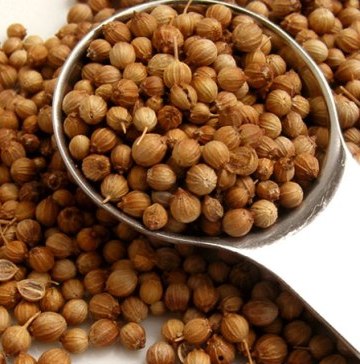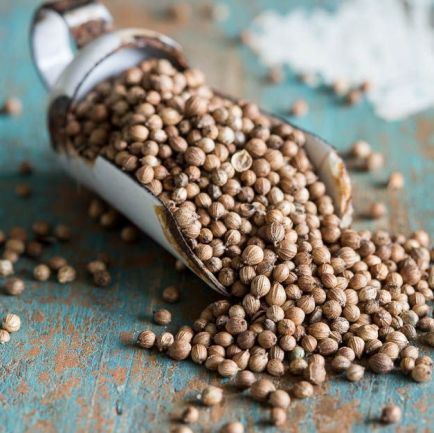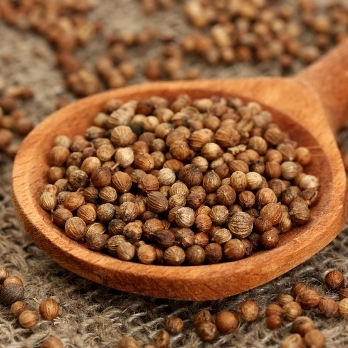.png)
.png)




Botanical name Coriandrum sativum L.
Family Apiaceae
Source Seeds
Origin India
Processing Method Steam Distilled
Color/Consistency A thin, colourless to pale yellow liquid.
Aromatic Summary / Note / Strength of Aroma Coriander Essential Oil has a slightly sweet, spicy, herbaceous smell similar to that of Cilantro, offering a middle note with a medium aroma.
Blends With Coriander Essential Oil blends particularly well with Bergamot, Cinnamon Bark, Ginger, Grapefruit, Lemon, Neroli, and Orange.
Product Abstract
The leaves have a very different taste from the seeds, which transpires into the oil profile. Many people find the smell of coriander herb oil very off-putting but still it is used in many flavourings.
The fresh leaves are an ingredient in many Indian foods (such as chutneys and salads); in Chinese and Thai dishes; in Mexican cooking, particularly in salsa and guacamole and as a garnish; and in salads in Russia.. Chopped coriander leaves are a garnish on Indian dishes such as dal.
The leaves for oil production are harvested before the plant starts to produce fruits (or seeds). This is usually late Spring. The oil itself has a limited shelf time so it’s not uncommon for buyers to pre-book their annual requirements ahead of the harvest as producers don’t wish to oversupply. As a result the market is always finely balanced as you rarely find an over-supply situation.
History
Coriander grows wild over a wide area of Western Asia and southern Europe, prompting the comment, "It is hard to define exactly where this plant is wild and where it only recently established itself. Fifteen desiccated Mericarps were found in the Pre-Pottery Neolithic B level of the Nahal Hemar Cave in Israel, which may be the oldest archaeological find of coriander. About half a litre (a pint) of coriander mericarps was recovered from the tomb of Tutankhamen, and because this plant does not grow wild in Egypt, Zohary and Hopf interpret this find as proof that coriander was cultivated by the Ancient Egyptians.
Extraction Information
Coriander obtained from the Leaf by soxhlet-dynamic headspace, solvent extraction , steam distillation, hydrodistillation and supercritical CO2 extraction were analyzed by GC-FID and GC-MS. The SC-CO2 offered a higher yield than the other used techniques. Among the identified constituents, linalool was the main compound whatever the employed extraction procedure in contrast to the remaining components which varied according to the isolation technique showing a strong effect of the method used on the composition of these minor compounds. SC-CO2 as compared to the other extraction techniques revealed its high efficiency in addition to the integrity saving of coriander fruit volatiles. Statistical analysis showed that all the detected and identified compounds were highly affected by the extraction technique used except the a-terpineol which appear stable.
Common Usage
Caution
There is nothing serious in terms of health risks, but if taken in excess, coriander essential oil can make you lose control over your senses for a while, as if you are spell bound. It is a powerful agent that impacts the body, but it can also impact the mind and cause you to lose the ability to think clearly or make decisions, so be careful.
Key constituents
Linalool 59.0–87.5%
a-Pinene 0.1–10.5%
g-Terpinene 0.1–9.1%
b-Pinene 0.1–8.6%
p-Cymene 0–8.4%
Camphor 1.6–7.7%
Geraniol 0.3–5.3%
Camphene tr–4.6%
(þ)-Limonene 0.2–3.2%
Geranyl acetate 0–3.1%
Terpinen-4-ol tr –3.0%
a-Terpineol 0.1–2.2%
Quality Coriander seed oil may be adulterated with natural or synthetic linalool.
Safety summary
Hazards None known.
Contraindications None known.
Regulatory guidelines
Has GRAS status. According to IFRA, essential oils rich in linalool should only be used when the level of peroxides is kept to the lowest practical value. The addition of antioxidants such as 0.1% BHT or a-tocopherol at the time of production is recommended.
Organ-specific effects
Systemic effects
Acute toxicity Coriander seed oil acute oral LD50 in rats >5 g/ kg; acute dermal LD50 in rabbits 4.13 g/kg.
Subacute & subchronic toxicity In a 28 day study in male and female rats, coriander seed oil with the same composition given above under Reproductive Toxicity, was administered by gavage at 160, 400 or 1,000 mg/kg/day. Increases in kidney and liver weight were observed in the high-dose males and females, and in some mid-dose animals. There were increases in total protein and serum albumin in mid- and high-dose males and high-dose females. Serum calcium was also increased in highdose males. Histopathological findings included a high incidence of degenerative lesions in the renal cortex of high-dose males, and a high incidence of hepatocellular cytoplasmic vacuolization in the liver of high-dose females. Some stomach lesions were observed in both mid- and high-dose females. No treatment-related effects on survival, clinical observations, bodyweight or food consumption were observed and there were no adverse effects in the reproductive organs of either sex at any dose. Based on the findings in this study the NOAEL was 160 mg/kg for male rats and less than 160 mg/kg for female rats.
Carcinogenic/anticarcinogenic potential Coriander seed oil was not mutagenic in the Ames test, and did not produce CA in Chinese hamster fibroblasts. Coriander seed oil dose-dependently inhibited aflatoxin B1-induced adducts in calf thymus DNA, in the presence of rat liver microsomes. The oil significantly induced glutathione S-transferase in mouse liver. (þ)-Limonene and geraniol display antitumoral activity.
Comments
Because of the high content of CNS depressant linalool, it is not thought that the camphor content of coriander seed oil will present a neurotoxic risk. This is borne out by the LD50 of the oil.